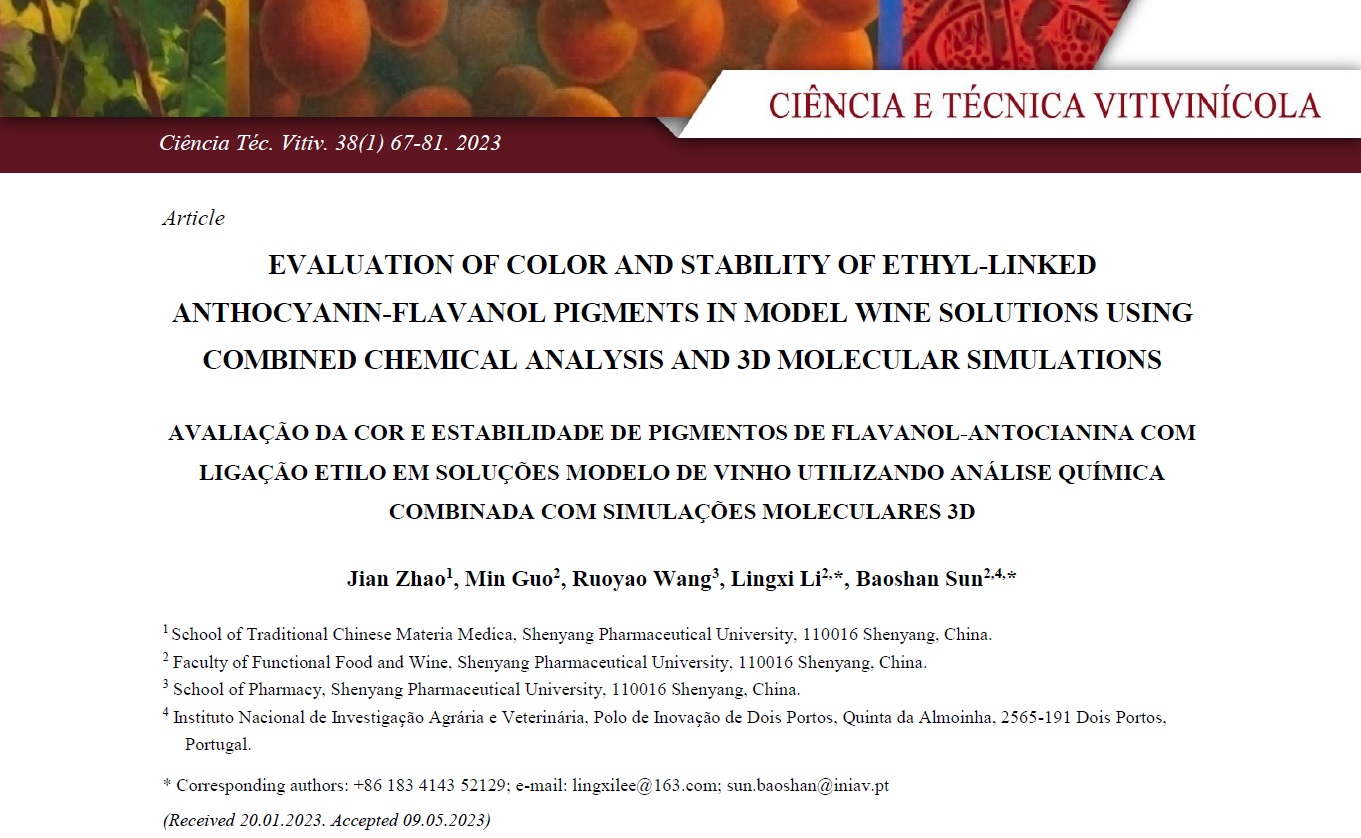 Avaliação da cor e estabilidade de pigmentos de flavanol-antocianina com ligação etilo em soluções modelo de vinho utilizando análise química combinada com simulações moleculares 3D
Avaliação da cor e estabilidade de pigmentos de flavanol-antocianina com ligação etilo em soluções modelo de vinho utilizando análise química combinada com simulações moleculares 3D
Evaluation of color and stability of ethyl-linked anthocyanin-flavanol pigments in model wine solutions using combined chemical analysis and 3D molecular simulations
Resumo
Os pigmentos de antocianina-flavanol com ligação etilo são um dos mais importantes produtos de condensação formados durante a vinificação e o envelhecimento do vinho tinto. Estes compostos têm uma importante contribuição para a cor e estabilidade dos vinhos tintos envelhecidos. Neste estudo, as características da cor e a estabilidade de pigmentos antocianina-flavanol com ligação etilo, bem como os seus precursores (antocianinas), foram avaliadas através da combinação de espectrofotometria e de simulações moleculares 3D. Em soluções modelo de vinho, as reações de condensação entre três antocianinas e (-)-epicatequina, mediadas por acetaldeído, foram conduzidas para produzir pigmentos de antocianina-flavonol com ligação etilo. As características da cor foram avaliadas pelo método CIELab e as alterações de concentração foram analisadas por HPLC-DAD. Por outro lado, a estabilidade dos pigmentos foi também calculada pelos três métodos de simulação molecular 3D, ou seja, mecânica molecular, dinâmica molecular e simulação de química quântica. Os resultados obtidos pelo método CIELab indicaram que a formação de pigmentos de antocianina-flavanol com ligação etilo originou uma diminuição dos valores de L*, a*, b* e C* e, inversamente, um aumento do valor de h*. As simulações moleculares 3D revelaram que a estabilidade das antocianinas foi a seguinte: Mv-3-O-glu > Pn-3-O-glu > Cy-3-O-glu. Os pigmentos de antocianina-flavanol com ligação etilo (cis ou trans) apresentaram muito maior estabilidade do que os precursores. De entre os pigmentos, a malvidina-3-O-glucósido-flavanol com ligação etilo revelou-se muito mais estável do que a cianidina-3-O-glucósido-flavanol com ligação etilo e do que a peonidina-3-O-glucósido-flavanol com ligação etilo.
Abstract
Ethyl-linked anthocyanin-flavanol pigments are one of the most important condensation products formed during the red winemaking and ageing period. They have great contribution to the color characteristics and stability of aged red wines. In this study, the color characteristics and stability of ethyl-linked anthocyanin-flavanol pigments and their precursor anthocyanins were evaluated by combined spectrophotometry and 3D molecular simulations. In model wine solutions, the condensation reactions between three anthocyanins and (-)-epicatechin, mediated by acetaldehyde, were conducted to produce ethyl-linked anthocyanin-flavanol pigments. The color was assessed by the CIELab method, and the concentration changes were analyzed by HPLC-DAD. On the other hand, the stability of these pigmented compounds was also calculated by the three 3D molecular simulation methods, that is molecular mechanics, molecular dynamics, and quantum chemistry simulation. The results obtained from CIELab analysis indicated that the formation of ethyl-linked anthocyanin-flavanol pigments resulted in a decrease of L*, a*, b* and C* values, and conversely, a rising of h* value. The 3D molecular simulations revealed that the stability of anthocyanins was as follows: Mv-3-O-glu > Pn-3-O-glu > Cy-3-O-glu. The cis or trans ethyl-linked anthocyanin-flavanol pigments were much more stable than their precursor anthocyanins. Among the pigments, ethyl-linked malvidin-3-O-glucoside-flavanol was more stable than ethyl-linked cyanidin-3-O-glucoside-flavanol and ethyl-linked peonidin-3-O-glucoside-flavanol.
Autores: Jian Zhao, Min Guo, Ruoyao Wang, Lingxi Li and Baoshan Sun (#INIAV)
DOI: https://doi.org/10.1051/ctv/ctv20233801067













